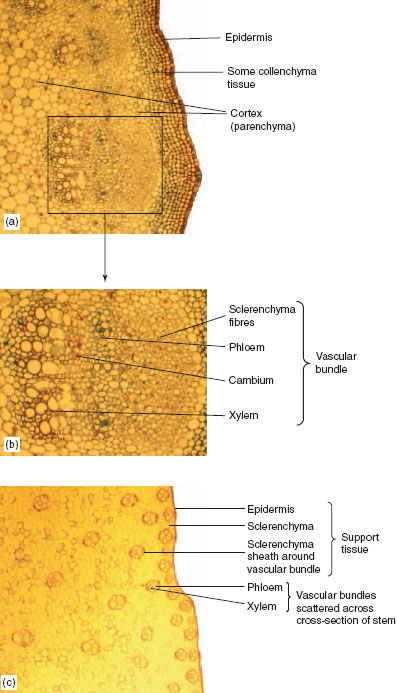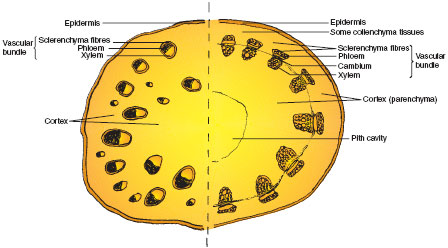Tissues of the stem
Content
Dicotyledonous stem The internal structure of a dicotyledonous stem, as viewed in crosssection, is shown in Figure 6.4. Three terms, epidermis, cortex and pith are used to broadly describe the distribution of tissues across the stem. The epidermis is present as an outer protective layer of the stem, leaves and roots. It consists of a single layer of cells; a small proportion of them are modified to allow gases to pass through an otherwise impermeable layer (see stomata). The second general term, cortex, describes the zone of tissues found inside the epidermis and reaching inwards to the inner edge of the vascular bundles. A third term, pith, refers to the central zone of the stem, which is mainly made up of parenchyma cells.
Collenchyma and sclerenchyma cells are usually found to the inside of the epidermis and are responsible for support in the young plant. Both tissues have cells with specially thickened walls. When a cell is first formed it has a wall composed mainly of cellulose fibres. In collenchyma cells the amount of cellulose is increased to provide extra strength, but otherwise the cells remain relatively unspecialized. In sclerenchyma cells, the thickness of the wall is increased by the addition of a substance called lignin, which is tough and causes the living contents of the cell to disappear. These cells, which are long and tapering and interlock for additional strength, consist only of cell walls. The cortex of the stem contains a number of tissues. Many are made up of unspecialized cells such as parenchyma. In these tissues, the cells are thin walled and maintained in an approximately spherical shape by osmotic pressure. The mass of parenchyma cells (surrounding the other tissues) combine to maintain plant shape. Lack of water results in the partial collapse of the parenchyma cells and this becomes apparent as wilting. Parenchyma cells also carry out other functions, when required. Many of these cells contain chlorophyll (giving the stems their green colour) and so are able to photosynthesize. They release energy, by respiration, for use in the surrounding tissues. In some plants, such as the potato, they are also capable of acting as food stores (the potato tuber which stores starch). They are also able to undergo cell division, a useful property when a plant has been damaged. This property has practical significance when plant parts such as cuttings are being propagated, since new cells can be created by the parenchyma to heal wounds and initiate root development. Contained in the cortex are vascular bundles, so named because they contain two vascular tissues that are responsible for transport. The first, xylem, contains long, wide, open-ended cells with very thick lignified walls, able to withstand the high pressures of water with dissolved minerals which they carry. The second vascular tissue, phloem, consists again of long, tube-like cells, and is responsible for the transport of food manufactured in the leaves carried to the roots, stems or flowers (see translocation). The phloem tubes, in contrast to xylem, have
|
||||||||||||||||||||||







